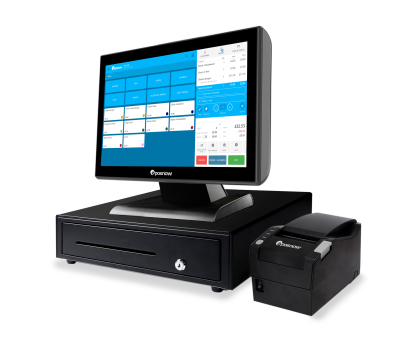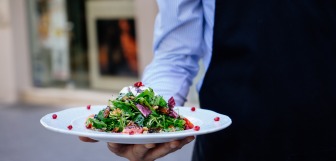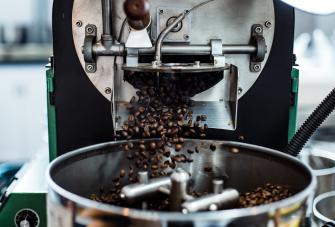How to Serve Food Correctly
Working as a server in a restaurant is all about making guests feel happy with their experience. Diners are not only paying for great food but also for excellent service. It is called the hospitality industry, after all.
The act of serving food is a major part of the restaurant experience, especially in fine dining establishments. Offering exceptional customer service is a great way to wow your guests and earn gratuities in the process.
In this blog, we’ve included a number of tips and tricks you can use to offer the best service at your job.
Types of service
Restaurants adhere to various models when it comes to the dining experience. There are many ways to serve guests, from counter-serve diners to opulent five-star restaurants.
Generally, most restaurants will follow one of these service models:
- Quick service: Popularized by fast food restaurants and other establishments, quick service is all about speed and convenience. A guest places their order, waits a few minutes at the counter, and leaves with their meal. Some quick service restaurants have a dining room, but not all.
- Fast-casual: Similar to quick service, a fast-casual restaurant will often take orders at the counter but have a dining room. Guests are usually given a table marker so the kitchen staff can deliver the meal. Sometimes, diners are given a buzzer to notify them when their food is ready at the counter.
- Casual dining: The standard for many restaurants, the casual dining experience focuses on great food and a good time at an affordable price. Guests are often seated by a host, and a server will take their meal orders. Then, the server will deliver the meals and periodically check in on the customers to ensure they are satisfied.
- Fine dining: The most refined level of service available, fine dining establishments provide unbeatable service in a high-class atmosphere. The customer experience includes outstanding hospitality, elegant decor, and tailored menus of unique, expertly-prepared meals.
For this guide, we will focus on food service in casual dining and fine dining restaurants. We will also imagine you have already seated the guest and sent their orders to the kitchen.
Picking up the meals from the kitchen
Kitchens are busy, noisy places. Even the best chefs make mistakes at times. Since first impressions matter, you want to ensure the orders are accurate before leaving the kitchen. Even if the back of house staff made a mistake, it would reflect poorly on you and the entire restaurant.
Make a habit of following this checklist:
- All meals are for the correct table
- All orders are accurate, including any substitutions
- Plates and bowls don’t have any defects
- Add additional cutlery such as steak knives and soup spoons
- Set condiments such as butter or sauces on the side
These small steps enhance customer service and can prevent you from sending food back to the kitchen or comping meals.
Gain all the advantages of an EPOS system with detailed, flexible, downloadable reports, and so much more:
- Manage and update products quickly with easy-to-use software
- Expand your business into multiple channels and integrate with a variety of online platforms
- Manage multiple locations and salespoints with multi-site management
- Keep queues short with streamlined, modifiable sales processes
- Choose a setup that suits you with software and hardware options

Placing meals on the table
Did you know that there is a right and wrong side to serve from? Perhaps your restaurant doesn’t abide by these traditions, but culinary traditions still matter to many guests.
Historically, meals were served from a communal tray. The waiter would scoop food from a plate or bowl and set it on an individual’s plate. Because of the logistics of doing this, it was proper to serve food from the left. Since most diners are right-handed, serving from the left was the least intrusive way of delivering food.
These days, however, almost all meals are presented on individual plates. The server only has to place it in front of the guest.
Remember, there are no hard and fast rules in the food service industry, unless you are in a fine dining establishment that sticks to traditions. Rather, you want to serve from the least-intrusive side.
In some cases, you might find yourself delivering from the left and right sides at the same time! If you have two plates in-hand, you can serve guests sitting opposite each other in one smooth motion.
When to serve from the left:
- Serving food from a shared platter, such as a Brazilian steakhouse
- Placing side dishes, such as rolls and salads
- Serving a booth or table that doesn’t have access on the right
When to serve from the right:
- Delivering meals pre-arranged on a single plate
- Placing drinks on a table
Serving wine
Wine is a favourite drink paired with dinner, but pouring wine is an art form in itself. Without the right technique, you can overfill a glass or accidentally spill it on a guest.
Follow these steps when serving wine:
- Gather your supplies: Be sure to bring the wine bottle, a wine glass for every guest, and your corkscrew. Keep in mind that some chilled wines require an ice bucket.
- Present the wine: As is tradition, be sure to present the wine bottle so the customer can confirm their choice. You will want to present the bottle’s label and verbally say the name, vintage, and any other details. Only open the bottle once they confirm.
- Offer a sample: The guest who ordered the wine will be the judge. After opening the bottle, place the cork in front of this person. Next, pour a tiny amount so the guest can taste the wine and swirl it in their glass. Once approved, you can begin pouring for the table.
- Pouring: Since wine glasses sit on the diner’s right side, you want to pour from the right. Otherwise, you will find yourself reaching over the customer’s plate. Even when dining with family, no one likes to feel someone in their personal space. After pouring for the first guest, walk clockwise around the table and fill each additional glass.
Clearing plates
No matter how you serve the food, you will always want to clear from the right side. Similar to how you pour wine, walk clockwise to pick up all remaining dishes.
In fine dining establishments, you do not want to stack plates on top of each other. Not only does this look messy, but it can lead to loud noises as glass clinks together.
Instead, set a tray on a nearby table out of sight. Here, you can stack your plates and efficiently take them to the kitchen.
Some general rules for serving
- Never touch a guest: Try your best not to bump into customers, especially when placing food. If you spill something, do not try wiping it off the guest.
- Never touch yourself: Appearances matter, so try to avoid touching your face or other body parts. If you must wipe off your hands, use a napkin or apron.
- Use open hand service: You should never reach over a guest or cross them at a perpendicular angle. Instead, serve from the left or right with the same hand. If serving from the left, use your left hand. If serving from the right, use your right hand.
- Serve food together: Bring appetizers, entrees, and desserts at the same time. Some guests order an appetizer as a meal, so it’s okay to ask if they want that first or with everyone’s meals.
- Don’t touch the rim of a glass: Carry all cups well below the top. This prevents the spread of germs and reassures guests that their glassware is clean. With wine glasses, only hold the stem.
Serve food better with the right point of sale
Customers hate waiting for their food, and nothing is worse for a diner than finally get their food only to see that their order is incorrect. Luckily, you can prevent these mishaps with the Epos Now Complete Solution.
Our electronic point of sales (EPOS or POS) are designed to drive profitability and make your life easier. We’re constantly striving to add new features to help restaurants and bars do business better.
With a modern restaurant EPOS, you can:
- Take orders tableside and send them to the kitchen
- Update your menu in real-time
- See what items are in-stock
- Accept all types of payment
If you’re interested in hearing more about Epos Now, get in touch with our expert team below.




